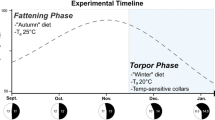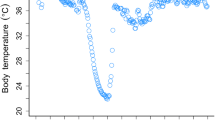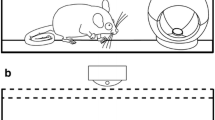Abstract
One of the energetic benefits of daily torpor over prolonged hibernation is that it enables animals to regularly forage and, therefore, replenish food reserves between bouts of torpor. However, little is known about the diet of predators undergoing torpor or whether differences in prey composition among individuals influence torpor characteristics. Here, we test the hypothesis that prey composition affects winter torpor use and patterns of a population of carnivorous marsupial, the brush-tailed mulgara (Dasycercus blythi), in the Great Sandy Desert, Australia. Mulgaras in the study population captured a wide range of prey including vertebrates (mammals, reptiles, birds), seven insect orders, spiders and centipedes. The proportion of vertebrates in the diet was negatively correlated with both frequency of torpor use and maximum bout duration. This variation in torpor use with diet can be explained by the higher energetic content of vertebrates as well as their larger size. Even assuming uniform intake of prey biomass among individuals, those that subsisted on an invertebrate-dominated diet during winter apparently suffered energetic shortages as a result of the scarcity of invertebrate taxa with high energy content (such as insect larvae). Our study is the first to demonstrate a link between diet composition and daily torpor use in a free-ranging mammal.



Similar content being viewed by others
References
Bell GP (1990) Birds and mammals on an insect diet: a primer on diet composition analysis in relation to ecological energetics. Stud Avian Biol 13:416–426
Boyer BB, Barnes BM (1999) Molecular and metabolic aspects of mammalian hibernation. Bioscience 49:713–724
Brigham RM, Körtner G, Maddocks TA, Geiser F (2000) Seasonal use of torpor by free-ranging Australian owlet-nightjars (Aegotheles cristatus). Physiol Biochem Zool 73:613–620
Brown JH, Bartholomew GA (1969) Periodicity and energetics of torpor in the kangaroo mouse, Microdipodops pallidus. Ecology 50:705–709
Chen X, Dickman CR, Thompson MB (1998) Diet of the mulgara Dasycercus cristicauda (Marsupialia: Dasyuridae), in the Simpson Desert, central Australia. Wildl Res 25:233–242
Christian N, Geiser F (2007) To use or not to use torpor? Activity and body temperature as predictors. Naturwissenschaften 94:483–487
Falkenstein F, Körtner G, Watson K, Geiser F (2001) Dietary fats and body lipid composition in relation to hibernation in free-ranging echidnas. J Comp Physiol B 171:189–194
Fietz J, Tataruch F, Dausmann KH, Ganzhorn JU (2003) White adipose tissue composition in the free-ranging fat-tailed dwarf lemur (Cheirogaleus medius; Primates), a tropical hibernator. J Comp Physiol B 173:1–10
Florant GL (1998) Lipid metabolism in hibernators: the importance of essential fatty acids. Amer Zool 38:331–340
Frank CL (1994) Polyunsaturate content and diet selection by ground squirrels (Spermophilus lateralis). Ecology 75:458–463
Geiser F (1990) Influence of polyunsaturated and saturated dietary lipids on adipose tissue, brain and mitochondrial membrane fatty acid composition of a hibernator. Biochim Biophys Acta 1046:159–166
Geiser F (2004) Metabolic rate and body temperature reduction during hibernation and daily torpor. Annu Rev Physiol 66:239–274
Geiser F, Kenagy GJ (1987) Polyunsaturated lipid diet lengthens torpor and reduces body temperature in a hibernator. Am J Physiol 252:R897–R901
Geiser F, Masters P (1994) Torpor in relation to reproduction in the mulgara, Dasycercus cristicauda (Dasyuridae: Marsupialia). J Therm Biol 19:33–40
Geiser F, Christian N, Cooper CE, Körtner G, McAllan BM, Pavey CR, Turner JM, Warnecke L, Willis CKR, Brigham RM (2008) Torpor in marsupials: recent advances. In: Lovegrove BG, McKechnie AE eds. Hypometabolism in animals: torpor, hibernation and cryobiology. 13th International Hibernation Symposium: University of KwaZulu-Natal, pp 297–306
Grayson KL, Cook LW, Todd MJ, Pierce D, Hopkins WA, Gatten RE Jr, Dorcas ME (2005) Effects of prey type on specific dynamic action, growth, and mass conversion efficiencies in the horned frog, Ceratophrys cranwelli. Comp Biochem Physiol A 141:298–304
Hiebert SM (1993) Seasonality of daily torpor in a migratory hummingbird. In: Carey C, Florant GL, Wunder BA, Horwitz B (eds) Life in the cold. Westview, Boulder, pp 25–32
Holm E, Edney EB (1973) Daily activity of Namib Desert arthropods in relation to climate. Ecology 54:45–56
Knox B, Ladiges P, Evans B, Saint R (2001) Biology, 2nd edn. McGraw-Hill, Sydney
Körtner G, Geiser F (2000) Torpor and activity patterns in free-ranging sugar gliders Petaurus breviceps (Marsupialia). Oecologia 123:350–357
Körtner G, Geiser F (2009) The key to winter survival: daily torpor in a small arid-zone marsupial. Naturwissenschaften. doi:10.1007/s00114-008-0492-7
Körtner G, Pavey CR, Geiser F (2008) Thermal biology, torpor and activity in free-living mulgaras in arid zone Australia during the winter reproductive season. Physiol Biochem Zool 81:442–451
Kunz TH (1988) Assessing insect availability. In: Kunz TH (ed) Ecological and behavioural methods for the study of bats. Sminthsonian Institution Press, Washington D.C., pp 204–207
Masters P (1998) The mulgara Dasycercus cristicauda (Marsupialia: Dasyuridae) at Uluru National Park, Northern Territory. Aust Mammal 20:403–407
Masters P (2003) Movement patterns and spatial organisation of the mulgara, Dasycercus cristicauda (Marsupialia: Dasyuridae) in central Australia. Wildl Res 30:339–344
Munro D, Thomas DW (2004) The role of polyunsaturated fatty acids in the expression of torpor by mammals: a review. Zoology 107:29–48
Ruf T, Arnold W (2008) Effects of polyunsaturated fatty acids on hibernation and torpor: a review and hypothesis. Am J Physiol 294:R1044–R1052
Schalk G, Brigham RM (1995) Prey selection by insectivorous bats: are essential fatty acids important? Can J Zool 73:1855–1869
Willmer P, Stone G, Johnson I (2005) Environmental physiology of animals, 2nd edn. Blackwell, Oxford
Acknowledgements
We thank numerous staff at the Queensland Museum, especially Patrick Couper and Susan Wright, for assistance during the identification of dietary items. We are grateful to Greg Fye for identifying reptile material and Barbara Triggs for identifying mammal hair in scats. Jim Clayton provided much appreciated logistic support and field assistance during the radio-tracking study. Parks Australia and the traditional owners of Uluru-Kata Tjuta National Park gave permission to carry out the study. Financial assistance was provided by the Australian Research Council.
Author information
Authors and Affiliations
Corresponding author
Rights and permissions
About this article
Cite this article
Pavey, C.R., Burwell, C.J., Körtner, G. et al. Vertebrate diet decreases winter torpor use in a desert marsupial. Naturwissenschaften 96, 679–683 (2009). https://doi.org/10.1007/s00114-009-0516-y
Received:
Revised:
Accepted:
Published:
Issue Date:
DOI: https://doi.org/10.1007/s00114-009-0516-y




